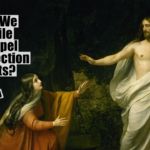To listen on YouTube, CLICK HERE.
QUESTION: HOW DO WE RECONCILE THE GOSPEL RESURRECTION ACCOUNTS? (FOLLOW UP)
Pastor Mike here.
This is a follow up to a recent video where I answered the Bible question: How do we reconcile the Gospel resurrection accounts?
I want to read from an article to supplement it entitled: Do the gospel resurrection accounts contradict each other?
It can be found at: compellingtruth(dot)org(forward slash)resurrection(dash)accounts(dot)html.
GENERAL RULES OF BIBLICAL INTERPRETATION
Now the following comes under the heading, “Some General Rules of Biblical Interpretation.”
It reads…
Before we address the specifics of the resurrection accounts, it is good to first understand a few basics of Biblical interpretation that will aid our understanding of why some things differ in the gospels. First, it’s important to remember that a partial report is not a false report. Just because each gospel author doesn’t report every detail of a story doesn’t mean it’s inaccurate. All historians edit their accounts for various purposes and the gospel writers are no different.
Second, a divergent account is not a false account. For example, Matthew speaks of one angel at Christ’s tomb whereas John mentions two. A contradiction? Not at all. Simple math says if you have two, you also have one. Matthew did not say there was only one angel; if he had then we would have a true contradiction. Instead, he just records the words of the one who spoke. Though divergent accounts can seem to cast doubt on the accuracy of the reporters, we must try and reserve judgment until all the facts are in.
THE GOSPEL RESURRECTION ACCOUNTS DO NOT CONTRADICT EACH OTHER
The article concludes…
The different perspectives in the gospel’s accounts of Christ’s resurrection are indicative of the veracity of the eye witness statements. Those who have seen something unexpected often report the details in somewhat of a frenetic and seemingly disconnected way, as they attempt to communicate the depth of what they have witnessed even while processing the events for themselves. Were the gospel writers or the disciples lying, they would have presented a uniform story. And the same critics who try to point out contradictions in the gospels would no doubt cry ‘collusion’ if they found exact verbal parallelism and a singular account of the resurrection.
In the end, the recordings of the resurrection found in the four gospels harmonize quite well upon closer examination, and perhaps most importantly, strongly agree on the one key fact that has universal life impact: Christ is risen from the dead!




